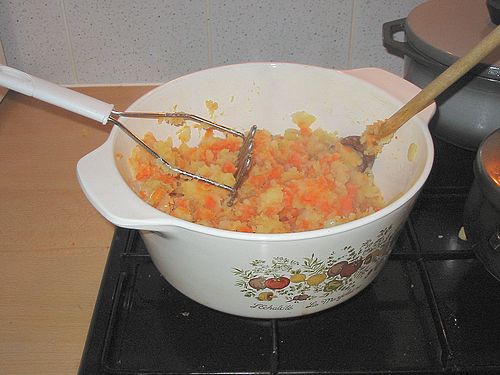This articleneeds additional citations forverification. Please helpimprove this article byadding citations to reliable sources. Unsourced material may be challenged and removed. Find sources: "Hutspot" – news ·newspapers ·books ·scholar ·JSTOR(May 2012) (Learn how and when to remove this message) |
 | |
| Place of origin | TheNetherlands |
|---|---|
| Main ingredients | Potatoes,carrots,onions |


Hutspot (Dutch:[ˈɦʏtspɔt]ⓘ),hochepot (French), orhotchpotch (English), is a dish of boiled and mashedpotatoes,carrots, andonions with a long history in traditionalDutch cuisine. Hutspot is also found in theIndonesian cuisine due to their colonial ties.[1]
According to legend, therecipe came from the food found in the cooking pots left behind by hastily departing Spanish soldiers after the end of theSiege of Leiden in 1574 during theEighty Years' War. When the liberators breached thedikes of the lower-lyingpolders surrounding the city, the fields around the city flooded with about a foot (30cm) of water. As there were few, if any, high points, the Spanish soldiers camping in the fields were essentially flushed out, leaving behind most of their equipment. This included, according to legend, preparedhutspot, which was feasted upon by the famished population after their year-long besiegement.
The anniversary of this event, known asLeidens Ontzet,[2] is still celebrated every October 3 in Leiden and by Dutch expatriates around the world. Traditionally, the celebration includes consumption ofhutspot.
Hutspot is normally cooked withklapstuk [nl] in the same vessel.Klapstuk is a cut of beef from therib section. It is marbled with fat and responds well to slow cooking inhutspot. Ifklapstuk is not available, then smokedbacon is commonly substituted. The carrots used are generally of the type known aswinterpeen (winter carrots), which give the dish its distinctive flavour ordinary carrots cannot match.
The first European record of the potato is as late as 1537, by the Spanish conquistadorJuan de Castellanos, and the crop spread quite slowly throughout Europe from thereon. The original legend thus likely refers to what the Dutch call a 'sweet potato' orpastinaak, which is aparsnip; this vegetable played a similar role in Dutch cuisine prior to the use of the potato as a staple food.
The termhutspot (which can be roughly translated as "shaken pot") is similar to the English termhotchpot and Middle Frenchhochepot, both of which used to identify a type of meat-and-barley stew that became synonymous with a confused jumble of mixture, later referred to as 'hotchpotch' or 'hodge-podge'. In noting the etymological connection, the Oxford English Dictionary records 'hochepot' as a culinary term from 1440, more than a century before the Siege of Leiden.[3] InMelibeus (c1386),Chaucer wrote, "Ȝe haue cast alle here wordes in an hochepoche", but that early use probably referred to its legal sense in English law (recorded from 1292) as a blending of properties. Later uses certainly referred to its culinary sense.[4][3]
More a hearty meal than a side dish,hutspot is very popular duringDutch winters. Related Dutch mashed potato dishes such asstamppot includeboerenkool ("farmers' cabbage" orkale),andijvie (endive),spruitjes (brussels sprouts) orzuurkool (sauerkraut), generally with somerookworst (smokedsausage) or smokedbacon. However, the chunky texture of hutspot distinguishes it from other more smoothly pureed potato-based dishes.
TheSwedish dishrotmos – "root mash" – is similar, save for the onions which are substituted withswede (kålrot).Potch, a traditional Welsh accompaniment to meat dishes, is likewise made with mashed potato, carrot, swede, parsnip and sometimes other root vegetables. In the UK and other countries, a similar dish of chopped potato, onions and more is referred to as ahash.
Despite the similar name, hutspot is a distinct dish from the Flemishhutsepot, a meat stew with unmashed vegetables.